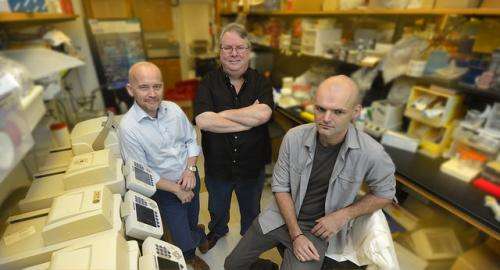Drs. Leszek Ignatowicz (from left), Richard A. McIndoe, and Lucasz Wojciech. Credit: Phil Jones
A fundamental theory about how our thymus educates our immune police appears to be wrong, scientists say.
It's known that stem cells come out of the bone marrow and travel to the tiny thymus gland behind the breastbone to learn to become one of two CD4T cell types: one leads an attack, the other keeps the peace.
One widely held concept of why they become one or the other is that, despite coming from the same neighborhood and going to the same school, they are exposed to different things in the thymus, said Dr. Leszek Ignatowicz, immunologist at the Medical College of Georgia at Georgia Regents University.
In this case, the "things" are ligands and developing T cells are potentially exposed to thousands of these tiny pieces of us inside the thymus. "Ligands are like our fingerprints," said MCG Postdoctoral Fellow Dr. Lucasz Wojciech.
But when MCG scientists limited exposure to only one fingerprint, the same mix of T cells still emerged, said Ignatowicz, a corresponding author of the study in the journal Nature Communications. "We asked a simple question: Is it going to affect their development and the answer was no," Ignatowicz said. "The cells still mature in the thymus, so something else must be determining it."
The finding provides more insight into immunity that could one day enable a new approach to vaccines that steer the thymus to produce more of whatever T cell type a patient needs: more effector cells if they have a bad infection or cancer, more regulatory T cells if they are experiencing autoimmune diseases like arthritis and multiple sclerosis. "We could help steer the education process in the desired direction," Ignatowicz said.
It's definitely a tough learning experience in the thymus. The vast majority of T cells learn to be too aggressive or too passive so never make it out of the thymus. About 90-95 percent of T cells that survive become effector cells, which will one day drive the response of the immune system to invaders such as bacteria, viruses, and tumors. Effector cells will learn to recognize and attack invaders once they are out roaming the body. Still these future aggressors are the ones that bind less strongly to ligands they experience in the thymus. "You wouldn't want an effector cell that bind strongly to yourself because you would attack yourself," explained Dr. Richard A. McIndoe, a bioinformatics expert and Associate Director of the MCG Center of Biotechnology and Genomic Medicine.
T cells that bind most strongly are the small, but essential percentage of regulatory T cells, or Tregs, which down-regulate the immune response and, ideally, prevent self-attack. It's a pretty powerful minority: Mice missing Tregs die within three weeks of birth; without a bone marrow transplant, humans will die as well as the body attacks major organs, Ignatowicz said.
In this study, the scientists had two mice, each expressing a single ligand in the thymus, one the researchers thought would prompt strong binding, so favor Treg development, and another that would favor a weaker bond and effector cell development.
While the mix of resulting T cells was the same as if both were exposed to the usual thousands of ligands, there was a difference. Ligands – and eventually bacteria and other invaders – get the attention of T cells by activating their receptors. Both CD4T cell types generally have the same receptors, just organized differently.
MCG scientists found as long as the binding was weak, as it was in the first mouse, there was a lot of overlap in the receptors the ligand bound to in both T cell types. However, in the second mouse, which should have favored Treg development because the ligand prompted strong binding, there was far less overlap. "We are now trying to find what causes that difference," Ignatowicz said.
Journal information: Nature Communications
Provided by Medical College of Georgia






















